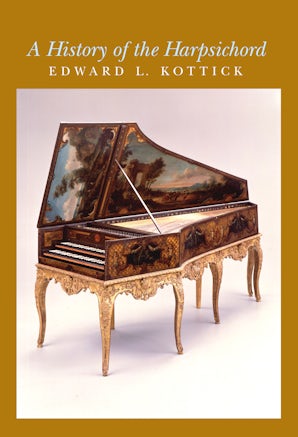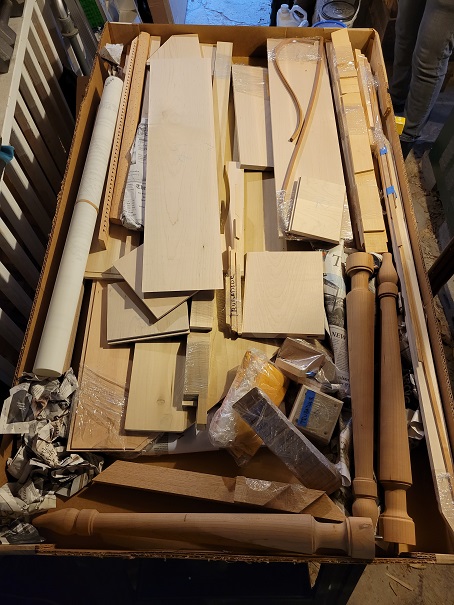Building a Virginal: The Ed Kottick Connection
March 8, 2023
New York, N.Y.
During the 18th century, several mathematicians attempted to come up with a formula that defined the motion of a vibrating string. These mathematicians included Brook Taylor (of the Taylor series) in England, Daniel Bernoulli and Leonard Euler in Switzerland, and Jean-Baptiste le Rond d’Alembert in France. But the problem required more sophisticated mathematical tools than were available at the time, and the problem wouldn’t be adequately solved until the techniques developed by Joseph Fourier.
Chapter 2 of my way-too-long-in-progress book Computer of the Tides explores this little slice of science history but stopping short of Fourier, who gets his own chapter. Although several musical instruments make sound using vibrating strings (including the violin, cello, guitar, harp, and piano), I decided to use the harpsichord as a hook or motif for the chapter. During the 17th and 18th centuries, the harpsichord expanded its role beyond a musical instrument to also became a scientific instrument for the exploration of sound and the mysterious phenomenon of vibration.
It was while working on Chapter 2 of Computer of the Tides several years ago that I decided that I couldn’t be writing about the harpsichord without having ever played one. I think that is what eventually led to my current project of building a virginal.
As research into the harpsichord for that chapter, I purchased a copy of this book published by Indiana University Press:
The back cover describes Edward L. Kottick as an “Instrument maker, scholar, researcher, author and lecturer, musicologist.” He is also a retired professor emeritus in musicology at the University of Iowa. Unfortunately his website no longer exists, but his Wikepedia entry indicates that he was born in 1930 in Jersey City, grew up in Brooklyn, majored in music at NYU, and got has PhD at the University of North Carolina, where he saw his first kit harpsichord.
Kottick is also the coauthor of an article in the February 1991 issue of Scientific American, “The Acoustics of the Harpsichord,” a copy of which I also acquired several years ago:
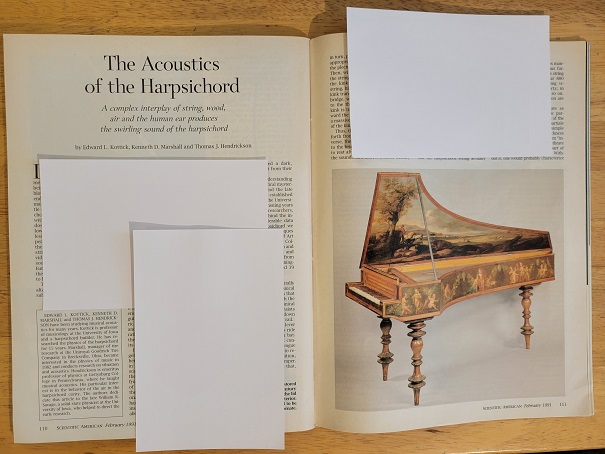
I’ve blocked out the text because the article is still under copyright and Scientific American sells access to it. Through JSTOR I was also able to access Kottick’s article in The Galpin Society Journal, “The Acoustics of the Harpsichord: Response Curves and Modes of Vibration”.
And so it was with much delight that I discovered that Edward Kottick was also the designer of the virginal that I’ll be building. Here’s the cover page of the 73-page PDF that Zuckermann supplies with the Troubadour Virginal kit to guide us through the construction process:
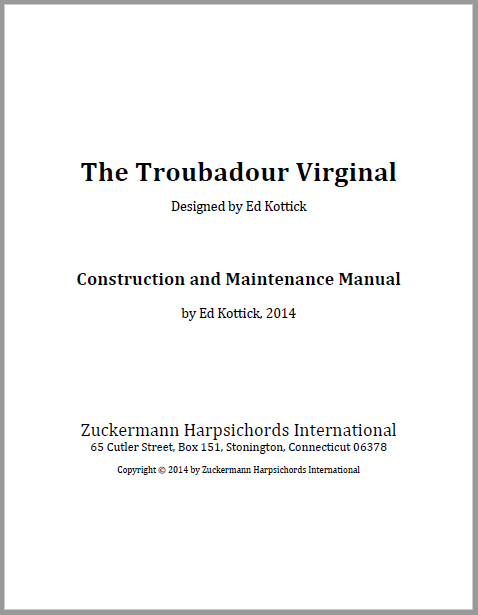
There’s a thin line between building a harpsichord and maintaining a harpsichord. Sometimes you see harpsichordists before a concert tuning their own instruments, as when I recently saw David Belkovski before a performance of a Handel cantata by the Twelve Night ensemble:
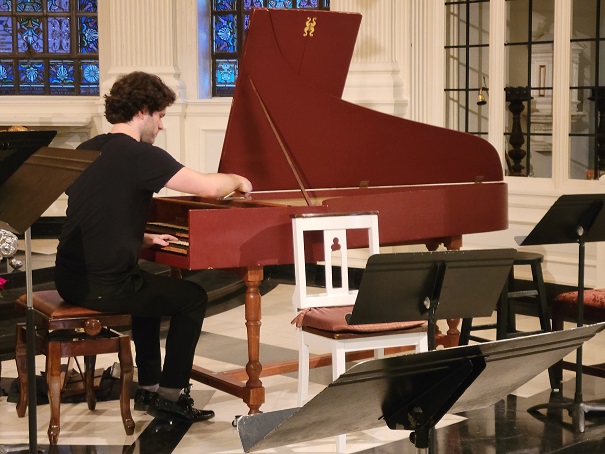
For that reason, I have also recently purchased the 1992 paperback edition of Edward Kottick’s 1987 book, The Harpsichord Owner’s Guide (The University of North Carolina Press, 1987, 1992) and have been reading it with much interest:
What I find most appealing is that the virginal that I’ll be building is fundamentally the same as virginals built 500 years ago. It is mostly wood held together by glue and screws and nails, and it will be strung with metal wires. The most significant difference is that the plectrum used to pluck the string will be a tiny piece of plastic, specifically, celcon. Historically, plectra were made from the shafts of birds’ feathers, or quills. (And if you assume that nobody uses quills anymore in their harpsichords, you would be wrong.)
Of course, there are some other differences as well. I am quite certain that 500 years ago people didn’t receive their virginals unassembled in a 5-foot by 3-foot by 6-inch box.
That’s me standing outside the basement door of our little house in the Catskills with the box in which Zuckermann packs the virginal kit. We took it inside, opened it up, and removed some of the paper packing:
Some of this is recognizable. Three legs are in the lower-right corner. Towards the upper right, two curved pieces of wood are the bridges, between which the stretched wires will vibrate. At the far left is a full-scale drawing of the case and soundboard on Mylar, used mostly for soundboard work. Next to it are the rack and the balance rail, which you became familiar with in my previous blog entry.
In a chapter on “The Modern Harpsichord” towards the end of A History of the Harpsichord, Edward Kottick discusses harpsichord kits and provides a little history of the Zuckermann company and other kit manufacturers. He writes that in the early days of Zuckermann, the harpsichord kit “was able to capture the interest of what was then known as the ‘do-it-yourself’ movement that swept through the Western world in the 1960s and 1970s. It was a discovery of the delight in working with one’s hands, and it coincided with both the general anti-establishment stance then common among youth, as well as the swelling popularity of Baroque music.” In contrast, he writes, today’s “average builder is a serious amateur harpsichordist who wants a quality instrument as well as the joy of building it.” (page 463)
That description almost fits me except I’m not sure that I’d call myself an “amateur.” My keyboard proficiency is clearly not even that. What I hope is that having an instrument whose keys have a direct mechanical connection to vibrating wires gives me more incentive to push myself than a keyboard that simply flips switches on and off. Perhaps by striving to reach the goal of “amateur,” I can forge new neural pathways in my brain and even stave off dementia.
It is thrilling to learn that the designer of the virginal that I’ll be building is also an expert in historical harpsichords inside and out. I hope I can do his work justice.
